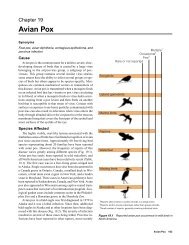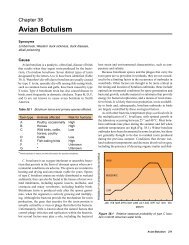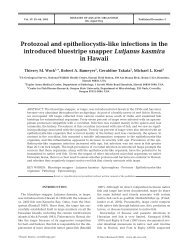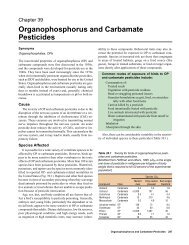Biowarfare, Bioterrorism, and Animal Diseases as Bioweapons
Biowarfare, Bioterrorism, and Animal Diseases as Bioweapons
Biowarfare, Bioterrorism, and Animal Diseases as Bioweapons
You also want an ePaper? Increase the reach of your titles
YUMPU automatically turns print PDFs into web optimized ePapers that Google loves.
Table 6.6. Dise<strong>as</strong>e agents posing the greatest potential threats from agroterrorism for livestock <strong>and</strong> poultry in the USA (list<br />
is from Wilson et al. 110 )—Continued.<br />
Agent Type Dise<strong>as</strong>e Zoonoses<br />
African horse<br />
sickness virus<br />
(Orbivirus)<br />
Bacillus<br />
anthracis<br />
Chlamydia<br />
psittaci<br />
Cowdria ruminantium<br />
New World<br />
Screwworm<br />
Cochliomyia<br />
hominivorax<br />
Virus African<br />
horse sickness<br />
(AHS)<br />
Bacteria<br />
Bacteria<br />
Rickettsia<br />
Par<strong>as</strong>ite<br />
Primary hosts<br />
Poultry Livestock Wildlife<br />
254 Dise<strong>as</strong>e Emergence <strong>and</strong> Resurgence: The Wildlife–Human Connection<br />
Comments a<br />
● ● Horses <strong>and</strong> then mules are the species<br />
most susceptible to this midge-transmitted<br />
virus; dogs become infected by feeding<br />
on infected meat <strong>and</strong> the virus may<br />
be spread by wind. Zebr<strong>as</strong> are reservoir<br />
host. AHS is most prevalent in the Middle<br />
E<strong>as</strong>t <strong>and</strong> Asia; it is not present in the<br />
Western Hemisphere. 192,196<br />
Anthrax ● ● ● Anthrax is worldwide in distribution <strong>and</strong><br />
causes fatal dise<strong>as</strong>e in humans, domestic<br />
animals <strong>and</strong> wildlife. Scavenger species<br />
relatively resistant to this dise<strong>as</strong>e aid<br />
its spread by opening the carc<strong>as</strong>ses of<br />
animals that have died <strong>and</strong> rele<strong>as</strong>ing<br />
large numbers of B. anthracis organisms.<br />
Ingestion by these species also serves to<br />
disperse the spores over broad are<strong>as</strong>. 199<br />
Ornithosis/<br />
psittacosis/<br />
chlamydiosis<br />
Heart-<br />
water/<br />
Cowdriosis<br />
Myi<strong>as</strong>is<br />
(screw<br />
worm)<br />
a Species groups generally involved in epizootics.<br />
Anthrax is a highly desired weapon of<br />
terrorists <strong>and</strong> biowarfare programs.<br />
● ● ● Dise<strong>as</strong>e introductions into the USA by<br />
pet bird trade (parrots, parakeets); dise<strong>as</strong>e<br />
exists in some USA waterbirds <strong>and</strong><br />
pigeon populations. 213<br />
● ● A very important vector-borne dise<strong>as</strong>e<br />
of livestock (cattle, sheep goats) in<br />
Africa. Also present in Madag<strong>as</strong>car <strong>and</strong><br />
some isl<strong>and</strong>s in the Indian <strong>and</strong> Atlantic<br />
oceans <strong>and</strong> in the Caribbean. 200 Naturally,<br />
occurring wildlife infections are generally<br />
subclinical but some mortality occurs in<br />
Africa. 201 White-tailed deer are highly<br />
susceptible to experimental infections.<br />
Importation into the USA of heartwater<br />
<strong>and</strong> exotic Amblyomma ticks that vector<br />
this dise<strong>as</strong>e could cost the livestock<br />
industry billions of dollars <strong>and</strong> result<br />
in major epizootics among white-tailed<br />
deer. 200<br />
● ● ● Screwworm fly is native to tropical <strong>and</strong><br />
subtropical North <strong>and</strong> South America;<br />
cannot overwinter in cold climates <strong>and</strong><br />
migrates to the north with onset of warm<br />
weather. Prior to control, one of the most<br />
important pests of livestock in the Southern<br />
USA where it caused millions of dollars<br />
in economic losses annually. 212

















